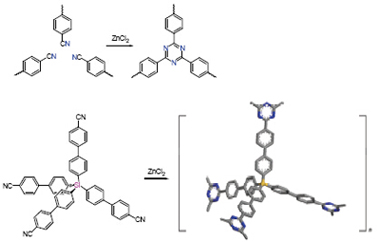| [1] Haszeldine, R. S. Science 2009, 325, 1647.[2] Leaf, D.; Verolmec, H. J. H.; Hunt, W. F. Jr. Environ. Int. 2003, 29, 303.[3] Rochelle, G. T. Science 2009, 325, 1652.[4] Vallee, G.; Mougine, P.; Julian, S.; Furst, W. Ind. Eng. Chem. Res. 1999, 38, 3473.[5] Lozano-Castello, D.; Cazorla-Amoros, D.; Linares-Solano, A. Carbon 2004, 42, 1233.[6] Demessence, A.; D’Alessandro, D. M.; Foo, M. L.; Long, J. R. J. Am. Chem. Soc. 2009, 131, 8784.[7] Nakagawa, K.; Tanaka, D.; Horike, S.; Shimomura, S.; Higuchi, M.; Kitagawa, S. Chem. Commun. 2010, 46, 4258.[8] Sumida, K.; Rogow, D. L.; Mason, J. A.; McDonald, T. M.; Bloch, E. D.; Herm, Z. R.; Bae, T. H.; Long, J. R. Chem. Rev. 2012, 112, 724.[9] Lee, J. Y.; Wood, C. D.; Bradshaw, D.; Rosseinsky, M. J.; Cooper, A. I. Chem. Commun. 2006, 25, 2670.[10] Ghanem, B. S.; McKeown, N. B.; Budd, P. M.; Al-Harbi, N. M.; Fritsch, D.; Heinrich, K.; Starannikova, L.; Tokarev, A.; Yampolskii, Y. Macromolecules 2009, 42, 7881.[11] McKeown, N. B.; Budd, P. M. Macromolecules 2010, 43, 5163.[12] Dawson, R.; Adams, D. J.; Cooper, A. I. Chem. Sci. 2011, 2, 1173.[13] Kuhn, P.; Antonietti, M.; Thomas, A. Angew. Chem., Int. Ed. 2008, 47, 3450.[14] Kuhn, P.; Thomas, A.; Antonietti, M. Macromolecules 2009, 42, 319.[15] Bojdys, M. J.; Jeromenok, J.; Thomas, A.; Antonietti, M. Adv. Mater. 2010, 22, 2202.[16] Yuan, D.; Lu, W.; Zhao, D.; Zhou, H.-C. Adv. Mater. 2011, 23, 3723.[17] Lu, W.-G.; Yuan, D.-Q.; Zhao, D.; Schilling, C. I.; Plietzsch, O.; Muller, T.; Brase, S.; Guenther, J.; Blumel, J.; Krishna, R.; Li, Z.; Zhou, H.-C. Chem. Mater. 2010, 22, 5964.[18] Ren, H.; Ben, T.; Wang, E.-S.; Jing, X.-F.; Xue, M.; Liu, B.-B.; Cui, Y.; Qiu, S.-L.; Zhu, G.-S. Chem. Commun. 2010, 46, 291.[19] Ren, H.; Ben, T.; Sun, F.-X.; Guo, M.-Y.; Jing, X.-F.; Ma, H.-P.; Cai, K.; Qiu, S.-L.; Zhu, G.-S. J. Mater. Chem. 2011, 21, 10348.[20] Yuan, Y.; Yan, Z.-J.; Ren, H.; Liu, Q.-Y.; Zhu, G.-S.; Sun, F.-X. Acta Chim. Sinica 2012, 70, 1446. (元野, 闫卓君, 任浩, 刘青英, 朱广山, 孙福兴, 化学学报, 2012, 70, 1446.)[21] Zhang, T.-T.; Wang, H.-T.; Ma, H.-P.; Sun, F.-X.; Cui, X.-Q.; Zhu. G.-S. Acta Chim. Sinica 2013, 71, 1598. (张婷婷, 王海涛, 马和平, 孙福兴, 崔小强, 朱广山, 化学学报, 2013, 71, 1598.)[22] Wang, W.; Ren, H.; Sun, F. X.; Cai, K.; Ma, H. P.; Du, J.-S.; Zhao, H.-J.; Zhu, G.-S. Dalton Trans. 2012, 41, 3933.[23] Patel, H. A.; Karadas, F.; Canlier, A.; Park, J.; Deniz, E.; Jung, Y.; Atilhan, M.; Yavuz, C. T. J. Mater. Chem. 2012, 22, 8431.[24] Dawson, R.; Stöckel, E.; Holst J. R.; Adams, D. J.; Cooper, A. I. Energy Environ Sci. 2011, 4, 4239.[25] Liang, Z.; Du, J.; Sun, L.; Xu, J.; Mu, Y.; Li, Y.; Yu, J.; Xu, R. Inorg. Chem. 2013, 52, 10720.[26] Dawson, R.; Stevens, L. A.; Drage, T. C.; Snape, C. E.; Smith, M. W.; Adams, D. J. Am. Chem. Soc. 2012, 134, 10741.[27] Wang, J.; Heerwig, A.; Lohe, M. R.; Oschatz, M.; Borchardt, L.; Kaskel, S. J. Mater. Chem. 2012, 22, 13911.[28] Rabbani, M. G.; El-Kaderi, H. M. Chem. Mater. 2011, 23, 1650.[29] Rabbani, M. G.; El-Kaderi, H. M. Chem. Mater. 2012, 24, 1511.[30] Gulam, R. M.; Reich, T. E.; Kassab, R.; Jackson, K. T.; El-Kaderi, H. M. Chem. Commun. 2012, 48, 1141.[31] Mohanty, P.; Kull, L. D.; Landskron, K. Nature Commun. 2011, 2, 401.[32] Liu, F. Q.; Tilley, T. D. Inorg. Chem. 1997, 36, 5090. |
